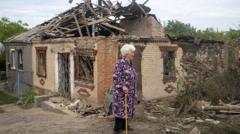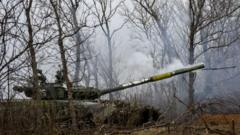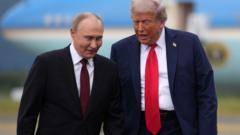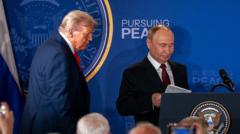Ukrainian authorities report ongoing Russian advancements in the Sumy region, with four villages reportedly captured. Analysts suggest these actions are part of a broader strategy to create buffer zones, while residents face increased attacks and evacuations.
Russian Forces Tighten Grip in Sumy Region, Potential Buffer Zone Creation
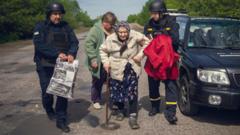
Russian Forces Tighten Grip in Sumy Region, Potential Buffer Zone Creation
As Russian troops make strategic gains in northeastern Ukraine, analysts suggest these advances are aimed at establishing buffer zones along the border, intensifying regional conflicts.
Russian military forces appear to be consolidating their presence in northeastern Ukraine, particularly in the Sumy region, in what local officials believe may be an effort to create buffer zones along the border. Oleh Hryhorov, the head of the Sumy region, reported that Russian forces have taken control of four villages and continue to engage in combat around other settlements, with the intent of establishing a "buffer zone."
In a recent announcement, Russian President Vladimir Putin outlined plans to create "security buffer zones" to protect regions in Russia adjacent to Ukraine's Kharkiv, Sumy, and Chernihiv areas. He stated that operations were underway to neutralize "enemy firing points" in an effort to bolster security for Russian territories near the border.
While local authorities indicate the capture of Novenke, Basivka, Veselivka, and Zhuravka by Russian troops, the official confirmation from Kyiv remains elusive. The Ukrainian military's communication strategy has limited disclosures, only noting clashes in the "Kursk direction." This confidentiality underscores the sensitivity of ongoing military activities and the situation's evolving nature.
In his recent address, President Volodymyr Zelensky commented on Russia's "preparation for new offensives," widely interpreted as an acknowledgment of the turmoil in the Sumy region. Monitoring groups, such as Deep State, have recorded the strategic capture of these villages by Russian forces—a push that has reportedly been ongoing since March, albeit at a slow pace.
Military observers state that Russian advances in the region, while significant, have not been exceptionally rapid, with only approximately one kilometer gained over the past two weeks. Notably, Colonel Vadym Mysnyk explained that Russian tactics rely on small, agile groups to avoid detection by Ukrainian drones, highlighting the challenges of utilizing larger armored units.
Sumy region has been under increasing fire from Russian airstrikes, with over 30 guided bombs reported to have been dropped since Saturday. Previous attacks have resulted in heavy civilian casualties, indicating a strategy targeting both military and residential areas to instill fear.
Local communities are under pressure, with evacuation efforts in 202 settlements along the front line, making up about a third of the region's total areas. Experts assert that these advancements can be interpreted as part of Russia's broader strategy to maintain tension and draw Ukrainian resources away from critical front lines, especially as the intense fighting continues in the Donbas region.
Looking ahead, analysts express skepticism regarding the feasibility of a major breakthrough by Russian troops in Sumy. The slow pace of territorial capture and the resilience of Ukrainian defenses suggest that significant Russian advances in major urban areas, like the city of Sumy, are unlikely in the near future. Ukrainian military efforts since 2022 have fortified their defensive positions along the border, although concerns remain about potential escalated Russian military engagement if their goals shift.






